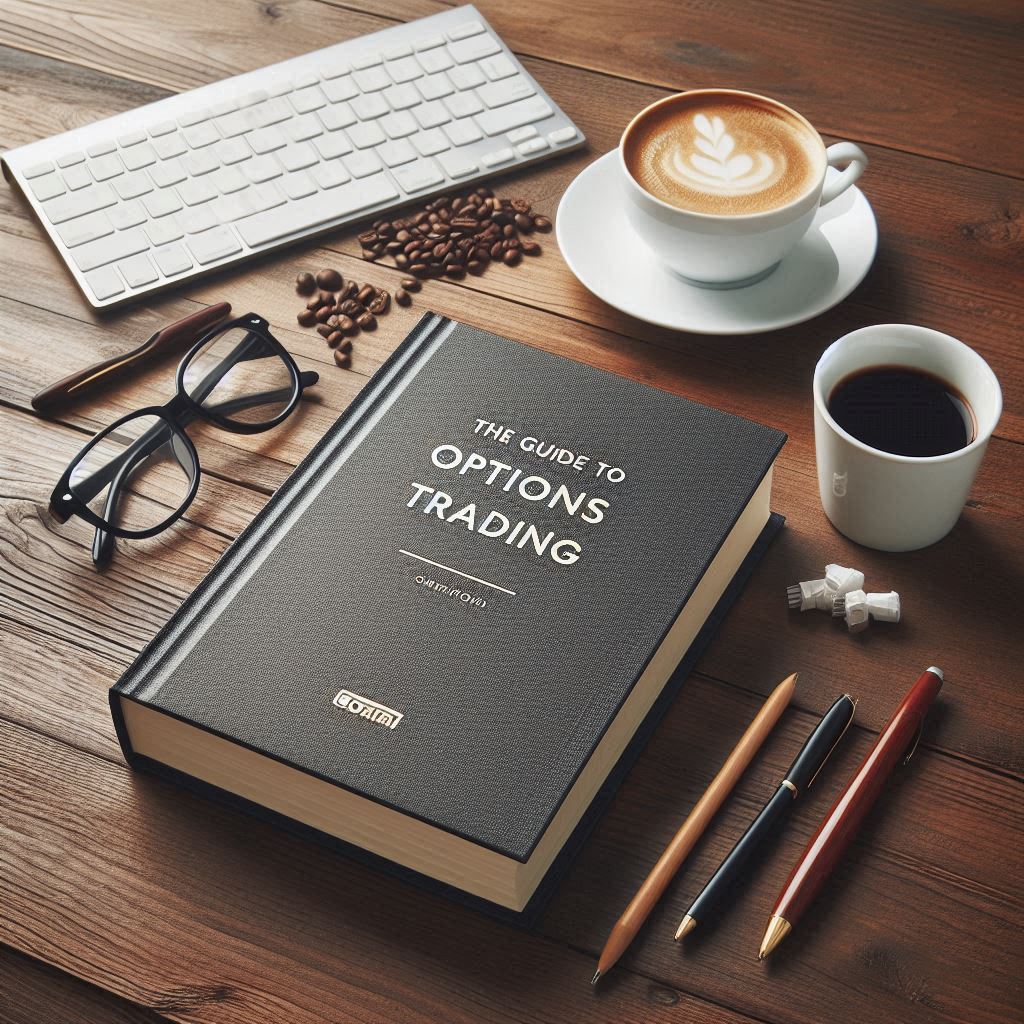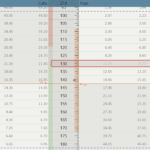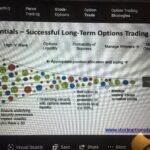In this 2024 Ultimate Guide to Options Trading (36 questions answered) we will attempt to answer several of the most asked questions new traders have about options.
We will start with a brief overview of the question and put it in the context of how you can use it to set up and manage trades. We will show you why it is important, how you can use it and finally how to use the ideas to manage the trades in your portfolio.
You can always click on the highlighted text to read a more complete discussion of the topic.
1. Do Options Traders make money
Options traders make money by both buying and selling options. A solid grounding in the basics is essential to effective trade management.
2. Is Options trading better than Stocks?
For traders who want to limit their risk to a certain amount, options can be a suitable alternative to stock. The amount you pay (debit) to control one hundred shares of stock is less than buying one hundred shares of stock outright. (Learn how to buy stocks at a discount).
The debit is the most you can lose when your buy options’. Keep in mind that options have time limits and if the underlying doesn’t move beyond your breakeven point, you forfeit the premium paid for the contract. Another factor to consider is time decay. Every option expires at a specific time and that time has value. When you buy a call option you want the stock to go up in value. Part of the debit your pay is time value, which works against option buyers. This is one of the reasons why options traders prefer to sell options. When your sell options’, your collect a credit and time decay works in your favor.
3. How do you trade Options?
Trading options involves buying or selling contracts that give the holder the right, but not the obligation, to buy or sell an underlying asset at a specific price on or before a certain date. Options trading can be complex and involves significant risk, but can also provide traders with opportunities to profit from market movements and manage risk in their portfolios. It is important for traders to have a solid understanding of options pricing, implied volatility, and the various trading strategies available before engaging in options trading.
Options traders can use a variety of strategies, including buying calls or puts, selling covered calls, and using spreads. Equally important is a solid understanding of the risks and rewards of each strategy, as well as the underlying asset being traded, before making any options trades. Additionally, options trading requires careful attention to market trends and an ability to anticipate potential price movements.
In order to trade options you need to open a brokerage account approved for options trading. Most firms allow you to trade depending on your level of experience and the size of your account. New traders may be limited to buying only options. Traders who can demonstrate a greater understanding of options can trade all the products a company offers. After your account has been approved, you pick the options you want to buy or sell and the duration of the contract. Directional bias, buying power requirements, and your level of risk and reward all figure into the way you set up your trades.
4. Can I trade Options with $100?
You can trade options with $100, if you can find a trade that requires only $100 of buying power and if your broker will allow you to trade with that level of capital. The most fundamental financial principles tell us that you cannot expect a significant reward if you are not willing to take a significant risk. So, from that point of view, it would be difficult to make much of a return by only risking $100. In addition, most brokerage firms require a minimum balance, which would limit your opportunities. An example might be selling a put option in Twitter (TWTR). The 20 put in the 40-day expiration would require $242 of buying power. This trade has a probability of profit of 99%. The max profit before commission is $ 8. The max loss would be $1992. It was hardly worth it in my book.
5. Are Options Gambling?
This is a question that traders hear all the time. It usually comes in the form of a statement from a personal acquaintance. You will hear someone say, “Options? Are you your crazy? Options are nothing more than gambling”. And that throws a cold blanket on your aspiration to learn how to trade options. Read about the 10 most useful rules of options trading. On the other hand, if you learn the basic trade setup rules. you will find that option trading is not gambling. It is in fact an excellent way to reduce risk in your portfolio. Look at any mutual fund prospective and read the fine print. Practically every mutual fund provider uses options to hedge their risk against adverse market moves.
6. Why are options so cheap?
The simplest answer is that options pricing is a function of supply and demand, For any market activity, when many people are buying and selling in the form of spreads. When people do this, no one is intending on letting the options get exercised thus driving the prices lower.
7. Why do options’ traders lose money?
Options traders lose money when they trade too big. By this I mean the size of their positions is too large relative to the size of their portfolio. For new traders with smaller accounts a position that uses more than 10% of their available buying power is too large. If you are trading in a defined risk position, such as an Iron Condor the max loss is the trade is the width of the spreads minus the credit you receive. Read this discussion of the benefits of Iron Condors The max loss for the defined risk is the buying power required to put on the trade. If you have a $1000 account, you will need to keep the buying power under 10%. Anything more than that is too risky for a new trader. Some sources caution against a trade that exceeds 5% of your available buying power.
8. Are options good for beginners?
Trading options can be a great strategy for diversifying your portfolio, limiting risk and generating profit — when executed well. Of course, it’s important to remember that no trades are risk-free, and options can result in major losses if you aren’t careful”.
One of the best reasons for trading options is the fact that it’s possible to make significant profits without necessarily having to have large sums of money. Because of this, it’s ideal for investors with little starting capital as well as those with larger budgets.
According to Investopedia, “[Options] have been around for more than 40 years, but options are just now starting to get the attention they deserve. Many investors have avoided options, believing them to be sophisticated and, therefore, too difficult to understand. Many more have had bad initial experiences with options because neither they nor their brokers were professionally trained in how to use them. The improper use of options, like that of any powerful tool, can lead to major problems. Check out this Basic Options training tutorial from Investopedia.
Finally, words like “risky” or “dangerous” have been incorrectly attached to options by the financial media and certain popular figures in the market. However, it is important for the individual investor to get both sides of the story before deciding about the value of options.
9. Who can sell options?
Options may be either bought or sold. Read how to sell short puts. If you are the holder of an options’ contract, you are the buyer and you pay a premium (debit) to enter in the position. If you buy a call, you are looking for the underlying to go up in price so you can buy it back later and profit from that price appreciation [see Buying Options). For every buyer there is a seller on the other side of the trade. The seller [writer] must fulfil the obligation of the contract holder (buyer) if the holder chooses to exercise the contract – either buy or sell the underlying stock. As you may suspect, the seller or writer of the contract is taking additional risk and should be compensated for that risk. Because of this risk, the seller receives the credit from the buyer. The buyer pays the debit. And the seller receives the credit less a small commission. In addition, since options contracts are wasting assets meaning they lose value as time passes, the seller has a statistical advantage over the buyer. At expiration the options’ contract price will decline to zero even if the price of the underling remains at the same that it was when the contract was bought or sold.
10. Are options trading worth it?
According to two sources, “Options can be an excellent investment vehicle to capitalize on short term price movements making them a worthwhile strategy. Advanced options’ trading combines the leverage benefit that options provide with the ability to hedge, providing smart traders a way to increase return probability while managing risk. Furthermore, some options’ trades are designed to lower an investor’s overall risk. Secondly, and more importantly, any worthwhile trading strategy involves techniques that reduce the risk of trading options while also boosting your profit potential. It’s that profit potential – the reward – that makes option trading worth the risk.
11. How much does an option cost?
An options’ premium consists of intrinsic value and extrinsic value. Intrinsic value is the amount by which an option is in the money (ITM). Let’s say the current price of an underlying is $105 and you wanted to buy the 100-call option. Since the price of the underlying is above the option strike price, the option would be ITM. In this case the intrinsic value portion of the premium is $5.00. In addition, if the quoted options’ price for the 100-call option is $6.75, this tells you that the extrinsic value portion of the premium is $1.75.
The extrinsic value is the price of time value and volatility which changes over the life of the contract.
A useful formula for estimating the extrinsic value of an options’ premium is:
Total premium – intrinsic value = extrinsic value. In this case $6.75 – $5.00 = $1.75
Out of the money (OTM) options’ have no intrinsic value. The premium is totally of extrinsic value. Extrinsic value can change over the course of the options contract. Time value decays and works to the advantage of an options’ sellers. Whereas time decay works against an option buyer.
12. What is the safest option strategy? Strategies Guide
The covered call is one of the safest option strategies that you can execute. In theory, this strategy requires an investor to purchase actual shares of a company (at least 100 shares) while concurrently selling a call option. Read here for a discussion of the Covered Call Strategy.
The covered call strategy is considered the safest options’ strategy for beginners. This may be so because it involves buying the underlying stock, which most traders have been doing for some time. The addition of a short out of money (OTM) call helps reduce the cost and lowers the breakeven point of the stock owned.
13. What is a strangle and a straddle?
Strangle is an undefined risk strategy that involves selling an out of the money put and a call at the same expiration. With the strangle you are looking for the price of the underlying to remain between the two options at expiration. Choosing the strikes using Delta and/or Volatility (expected move) are two common methods you can use to choose the strikes. Both delta and volatility can indicate the degree of the expected move of the underlying over the duration of the contract. If the stock moves too far in the direction of either option, you could roll the untested option in the direction the stock is moving and thereby collect additional credit. This helps reduce the risk of adverse moves. I will cover Rolling as topic further on. A straddle requires that the put and call be at-the-money and the same expiration. You would be looking for the underlying to not move in either direction.
14. What is the butterfly trading strategy?
In trading, a butterfly is a limited risk non-directional option strategy that is designed to have a high probability of earning a limited profit when the future volatility of the underlying asset is expected to be lower or higher than the assets implied volatility. The butterfly combines a bull and bear spread with a fixed risk and capped profit. This is a market neutral strategy and pays off the most when the underlying asset does not move prior to option expiration.Read here for a discussion of the Butterfly strategy
According to Investopedia, applies to a metric that captures the market’s view of the likelihood of changes in each security’s price. The IV of a stock is synonymous with 1 Standard Deviation price range in that Stock. IV represents the expected more of the underlying up or down. For example, if a stock is trading for $100, and it has a 20% IV the 1 Standard Deviation ranges for that stock over the course of the next 12 months are $80 – $120. To find these values we simply multiply the price of the underlying ($100) by 20%.
15. What is Implied Volatility in the stock market?
For a 1 STD move we expect the price to range between $80 – $120 (1 x 20 = 20 )
For a 2 STD move we expect the price to range between $60 – $140 (2 x 20 = 40 )
For a 3 STD move we expect the price to range between $40 – $160 (3 x 20 = 60 )
One cool thing about standard deviation & IV is that, when IV is high, you can obtain these probabilities using wider strikes, which means there is a larger implied range the stock can move. That directly translates to higher probabilities of being out of money (OTM) for further strikes. So, if you are concerned that the strikes you want to use will be in the money (ITM) by expiration, and IV is high, you can use wider strikes and widen the range of expected move in the underlying. If the expected move is $20 on a $100 stock, when IV is 20%, (80 – 120), the expected move for the same is $40 (60 – 140, if the IV moves up to 40%. That’s the power of high IV.
16. How do you use Implied Volatility when trading Options?
Implied Volatility is a metric that captures the market’s view of the likelihood of changes in a security’s price. Investors can use it to project stock future moves and often employ it to price options contracts. Implied volatility is a key component in options pricing. It is a measure of market sentiment and reflects the uncertainty and risk of the underlying asset. Traders can use implied volatility to analyze the potential profitability and risks of an options trade, and adjust their trading strategies accordingly.
One common strategy is to buy options with low implied volatility and sell options with high implied volatility. This is known as a volatility spread. When implied volatility is low, options are relatively cheap, and traders can buy them with less upfront capital. Conversely, when implied volatility is high, options are more expensive, so traders can sell them for a higher premium.
Another strategy is to use implied volatility to anticipate potential market movements. High implied volatility indicates that the market is expecting a significant move in the underlying asset, while low implied volatility suggests that the market is anticipating little movement. Traders can use this information to make informed decisions about which options to buy or sell.
Read here about Implied volatility when setting up trading options.
Let’s say you have a stock whose price is $100 with an IV of 30%. If you want to trade an options contract on that stock and can accept the probability of the price remaining between $70 and $130 over the next 12 months (theoretically) you could place your strikes outside that range and be confident that your strikes can remain out of the money by expiration with a 68% probability of success.
Read here for a discussion about How High Implied Volatility Improves Options Trading Performance
17. What are puts and calls?
A call option gives the holder (buyer) the right, but not the obligation to buy 100 shares of the underlying stock at the strike price on or before the expiration date of the contract. A Put option gives the holder (buyer) the right to sell 100 shares of the underlying stock on or before the expiration date of the contract. The seller of a short put receives a credit for taking the risk of being assigned.
18. What are the “Greeks” in options trading?
The ‘Greeks” measure risk in options’ trading. The four most used Greeks are delta, theta, Vega, and gamma. These Greeks help measure the sensitivity of an options’ price to quantifiable factors. For instance, delta measures the sensitivity of an options’ premium to the change in the price of the underlying stock, or other security depending on the underlying you are trading. Theta can tell you how the price of the option will change as time passes. Over all the Greeks are a way to help you understand your risk exposure in an individual position or the overall portfolio. Delta speaks to directional risk, while theta speaks to potential daily reward. A delta/theta ration indicates risk to reward. Delta/theta ratio expands as price falls; this ratio is a proxy for risk. So, the higher the ratio, the higher the risk in the position or portfolio as market falls. The lower the ratio the lower the risk. The opposite holds true also, The higher the ratio, the higher the risk. A ratio of 2:1 is often considered acceptable. In addition, for a 1 standard deviation short strangle positions, we should expect to see a range of delta/theta of +/-5.
19. What does Delta mean in Options trading?
Delta is one of the options greeks you can use to better understand the risk and reward of your options position(s).
Typically you hear that Delta is used to measure how an option’s price changes in relation to a move in the price of the underlying. However, delta can also be used to tell you about directional risk, share equivalency, and the probability of your option position being in the money by expiration.
20. Which options have the highest delta?
The in-the money options’ have the highest delta. The delta for the ITM options is close to 1. Call options’ have Positive delta and put options’ have negative delta. Positive and negative refers to the direction of the underlying. Delta refers to share equivalency. An options contract is equivalent to 100 shares of stock. If you sell an out of the money, put option, say a 30-delta put,
This is equivalent to taking the risk of a 30-share position in the underlying today. The holder of the contract has the right to sell these shares to you on or before expiration at the 30 delt strike of 178. You are paid a credit for taking that risk. Selling a put is a bullish position because your will be long 100 shares of XYZ stock at 178 if the price falls from its current price to 178 and the contract holder exercises his position. As the seller of the 178 put option you want the price of the underlying to go up. If the price of the underlying stays above 178, the contract will expire out of the money, and you will keep the credit. If the price falls from its current price down to 178 by expiration, you may be obligated to buy the shares at 178. As the stock falls in price toward 178, the delta will expand and move closer to 1. Earlier you saw that an in the money option has a delta of 1. At expiration, if the price of the underlying is 178 or below, the put option will be in the money and have a delta of 1 and equivalent to 100 shares of stock.
21. Can you use technical analysis in Options Trading?
Technical analysis is one of many tools used in trading options. Some traders use technical analysis because it focuses primarily on price, and they feel this gives them an edge. Other traders use fundamental information to set up trades. Another method of analysis uses volatility and mean reversion as the basis of trade set up. Learn about two technical analysis tools in this post.
22. What is exploding IV?
Exploding IV is a term used to describe the increase in volatility when the price of the underlying moves suddenly up or down after the market opens for the day. IV can move suddenly higher on the head of some news event or development such as unfavorable earnings news or political event. Option premiums expand when volatility increases followed by a sudden move in price. As participants see a sudden change in price. Volatility is an investment term that describes periods of unpredictable and often sharp variations in price movement. Volatility can spike in both up and down markets.
23. What is Implied Volatility rank?
According to investopedia Implied volatility is the measure of future movements in a particular stock. But how do we know if an IV of 20% in SPY is high enough to warrant selling premium? One way to know this is to look at hand implied volatility rank. IVR uses the low point and the high point of a year’s worth of IV data and gives out a number (0-100%) that says how high or low IV is now relative to the past year’s data. The higher the IV Rank, the better the chance that IV will revert to its mean value and provide option sellers with profits. Looking at raw IV in conjunction with IV Rank provides a good metric as to whether to sell or buy options. When IV is high, premiums are high and when IV is low, premiums are low. We like to sell options when premiums are high and close the position when IV and premiums contract. Sell high and buy low.
24. Can you always roll an undefined risk trade for a credit?
If the option you want to roll is out of the money, then rolling up, down or out can be done for a credit. This is true because there is always more time in the future and time is money. When your roll a strike you are doing so to increase your extrinsic value in the trade. Remember Extrinsic value = time value + volatility value. In “Greek” terms, Extrinsic value = theta + Vega.
25. How do you manage a strangle
A strangle is an undefined risk strategy composed of a short put and a short call. A good starting point for the strangle is to sell the put and call at the 16-delta strike, which is 1 standard deviation from the mid-price of the underlying. With this strategy you would take profit if/when you reach 50% of max profit. If you have collected $200 credit for opening the trade and the price to close is $100, you close the trade for $100 profit. You put the trade on as a package and take it off as a package. We don’t leg out of the trade. As you can see, managing winners is straight forward. Managing losers is a bit more complicated. Click here for a more complete discussion of managing a strangle.
26. What is an inverted trade?
An inverted trade is one in which the short call is rolled to a strike below the short put, or the short put is rolled to a strike above the short call strike. A trader may decide to invert the strikes to manage a trade.
27. What is beta-weighted Delta?
Beta-weighted delta on a portfolio is one number that you can tell how much your portfolio can move up or down if the index moves 1 point. It allows you to assess all your positions relative to a move in the market (if weighted to the SPY) or a specific symbol. In other words, it tells the theoretical dollar move of the portfolio or a position given a $1 move in the underlying that you are beta-weighting to. Another way to say this is that an investor puts all their positions into one standard unit. It’s a way to look at the entire portfolio and understand how it will change with a move in the market. Beta weighting will indicate the size, diversity, and general risk of the portfolio positions.
28. What is the difference between Risk and Uncertainty?
The difference between risk and uncertainty can be defined as follows: Risk can be defined as the situation of winning or losing value. Uncertainty is a condition where there is no knowledge about future events. Risk can be measured and quantified.
29. What is the Jade Lizard option strategy?
The Jade Lizard is a slightly bullish option strategy that is designed to eliminate upside risk by combining an out of the money short put with an out of the money short call spread. As long as the total credit received in the trade is greater than the width of the call spread there is no risk to the upside. Here is a link about how to trade the Jade Lizard Option strategy.
30. How to learn to trade options
You can learn how to trade options through several sources. If you already have an account with a broker check their resources. Most reputable brokerage firms have a good selection of rbooks and article to reference. If you don’t have a brokerage account, you might want to surf on over to tastytrade. I have had my account with tastytrade for many years and find their financial information, services, and support first rate.
In addition you can find a wide array of trading resources on the Chicago Board Options Exchange website (CBOE). You will find information about strategies, historical options data, volatility, training videos, etc.
You can also check out my article about resources for new options traders.
31. What is the Short Put strategy
Short Put Option Strategy is employed when a trader sells or writes a put option on an underlying security. A trader does this in order to profit from an increase in the stock’s price by collecting a credit for the sale of the option contract. cash secured puts
If you’d like to learn how to trade this strategy, here’s a brief article I wrote on the topic.
32. What is an options pricing model
An options pricing model is a mathematical formula used to estimate the fair value of an option. The most commonly used model is the Black-Scholes model, which takes into account factors such as the underlying asset’s price, the option’s strike price, the time until expiration, and the volatility of the underlying asset. Traders can use these models to determine whether an option is overvalued or undervalued, and make trading decisions accordingly. However, it is important to note that options pricing models are based on assumptions and estimates, and may not always accurately reflect the true value of an option.
33. What is options Spread Trading
Option spread trading involves simultaneously buying and selling two or more options with different strike prices or expiration dates. This allows traders to limit their risk and potentially increase their profits. Common option spreads include the butterfly spread, iron condor, and credit spread. It is important for traders to have a solid understanding of the risks and rewards of each spread before making any trades, as well as the market conditions that may affect the success of the spread.
34. What is a Ratio Spread
A ratio spread is an options trading strategy that involves buying and selling options with different strike prices and different expiration dates. It is similar to a vertical spread, but involves a different number of options contracts. The goal of a ratio spread is to limit risk while still allowing for potential profit. Traders should be aware of the risks involved, including the potential for losses if the underlying asset moves too far in one direction.
35. What do we mean by option Liquidity
Liquidity in options trading refers to the ease with which options contracts can be bought or sold without significantly affecting their price. It is determined by the volume of trading activity and the number of open contracts available in the market. High liquidity provides traders with better opportunities for entering or exiting positions at desired prices, as well as tighter bid-ask spreads. On the other hand, low liquidity can result in wider spreads and increased slippage. Overall, liquidity is a crucial factor to consider when trading options, as it affects the efficiency and cost-effectiveness of executing trades.
36. What is Probability in Options trading
Probability in options trading refers to the likelihood of a specific event or outcome occurring. It is used to assess the potential risks and rewards associated with different trading strategies. By understanding the probability of certain market movements or price changes, traders can make more informed decisions and manage their positions effectively. Probability is often calculated using statistical models and historical data, providing traders with insights into the expected outcomes of their trades.








